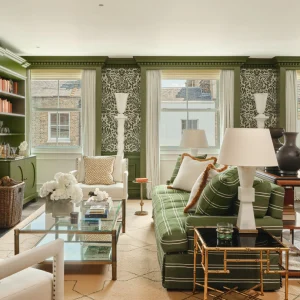 The original Ninja Tune releases were given a generic ‘house bag,’ a bright yellow sleeve with a hole cut in the middle. The label, 20 years old this year, was mainly releasing singles and the design was simple: a Ninja stamp and the name of the label in Frankfurt Gothic Condensed down the side. This work was carried out under the direction of Mark Porter, who went on to redesign The Guardian newspaper in 2005. This simple but marketing-savvy idea ensured that the label’s releases stood out on the shelves against the traditional black and grey house sleeves of its rivals. Yet it was the arrival of creative director Kevin Foakes, aka Strictly Kev, in 1993 having studied at Camberwell College of Art that bought a step-change in the label’s design identity. Foakes’ appointment coincided with a period of commercial growth and critical recognition allowing further exploration of the design of its products. Soon after taking charge, Foakes redesigned the Ninja mascot and ordered that the house sleeve to be assembled inside out, so the rough cardboard was exposed and the glossy yellow was hidden inside. ‘This helped us to establish our identity,’ says Foakes. ‘It gave the records a bit more grit, something we were about.’
The original Ninja Tune releases were given a generic ‘house bag,’ a bright yellow sleeve with a hole cut in the middle. The label, 20 years old this year, was mainly releasing singles and the design was simple: a Ninja stamp and the name of the label in Frankfurt Gothic Condensed down the side. This work was carried out under the direction of Mark Porter, who went on to redesign The Guardian newspaper in 2005. This simple but marketing-savvy idea ensured that the label’s releases stood out on the shelves against the traditional black and grey house sleeves of its rivals. Yet it was the arrival of creative director Kevin Foakes, aka Strictly Kev, in 1993 having studied at Camberwell College of Art that bought a step-change in the label’s design identity. Foakes’ appointment coincided with a period of commercial growth and critical recognition allowing further exploration of the design of its products. Soon after taking charge, Foakes redesigned the Ninja mascot and ordered that the house sleeve to be assembled inside out, so the rough cardboard was exposed and the glossy yellow was hidden inside. ‘This helped us to establish our identity,’ says Foakes. ‘It gave the records a bit more grit, something we were about.’

The company, founded by computer programmer Matt Black and ex-art teacher Jonathan More, who perform under the name Coldcut, had humble beginnings. The label had a temporary home in a borrowed north-London studio and was primarily a means for the pair to release their own tracks. Black and More were keen to retain creative freedom and not submit to commercial pressures of the music industry. This independence and do-it-yourself attitude has underpinned the ethos behind Ninja Tune’s distinctly bold music and design. Some of the earliest releases for DJ Food and DJ Toolz were highly graphic and 2D; the designs were hand-drawn and set by the printers as the use of computers in design was in its infancy. Record-sleeve designers were working in studios in their homes, as were the musicians. Despite the growth of the company, the experiments that formed the musical and visual catalogue were labours of love, often improvised while learning to stretch the limits of the tools available.

Over time the Ninja Tune packaging developed as an increasingly sophisticated representation of the intangible product it contained. The status of the physical object was treated with equal reverence to the music itself; one of the label’s great strengths is that it transcends any particular genre. Indeed, it remains home to some of the most inventive musicians in the UK, who share the ability to make experimental music accessible. These include British hip-hop artist Roots Manuva, nu-jazz DJ Mr Scruff, godfather of grime Wiley and, until recently, female rapper and 2009 Mercury Prize-winner Speech Debelle. This eclectic stable of musicians, inevitably, has attracted equally diverse graphic talents.

A key milestone in the development of Ninja Tune’s design identity is Foakes’ cover of downtempo breakbeat artist Funki Porcini’s 2002 album Fast Asleep. The cover is entirely made using Photoshop. The only things that are real in the image are the girl and the newspaper, both of which were sourced by Foakes off the Internet. The cover is a reflection of the nature of the music it represents, in that it is fabricated using a computer – as are the loops, beats and samples that make up the individual tracks. It’s a collaborative process, says Foakes: ‘the way I generally work is to speak to the artist first and ask “what do you want? If you have something very specific let’s go down that route, if it works, let’s make it and put it on the page; are you happy with that and am I happy with that?”’

Architect-turned-designer Nigel Peake produced the artwork for Coldcut’s 2006 album Sound Mirrors. ‘I basically chucked it at Nigel and said “do you want to do it?”’ says Foakes, ‘he hadn’t done an album cover before. I think he really pulled it off, though.’ The result is an architectural, 3D object that reflects the experimental nature of the record. The intricate drawings are printed onto die-cut card that folds out in a number of directions. The packaging is explored in a manner similar to understanding the music; each aspect demands attention and can be understood as an individual layer or as a whole entity.

More recently, Ninja Tune employed designers Oscar and Ewan to produce the cover for Roots Manuva’s 2008 Slime and Reason album on offshoot label Big Dada. The London-based design practice created a bust of the artist Rodney Smith before filling the plaster cranium with objects that reflected the nature of the singles, including bananas and a green slime. The bust was created by 3D-scanning Smith’s head, rapid prototyping it, and and then making a mould which could be used to create multiple plaster versions. The duo’s approach to design is a marked progression for the label, from its initial 2D graphics, to developing 3D images, through to making objects from the artwork and, most recently, building the 3D objects and environments to be photographed. A notable example is Wiley’s Playtime is Over cover from 2007, which involved painting a children’s playground in matt black.
 Album design has a habit of defining a designer or artist; from Peter Blake’s seminal work for The Beatles to Jamie Reid’s Never Mind the Bollocks and Peter Saville’s work with Factory Records. Ninja Tune may not be as tightly branded as Saville’s work for Factory Records, with its infamous cataloguing system that concluded with founder Tony Wilson’s coffin being labelled after the site of its HQ and club venue, FAC 501. Yet Ninja Tune has always been about performance; from live music, to video, to packaging and club nights, it has never become complacent and has remained true to the spirit of its Ninja mascot – constantly responding to the shifting, often turbulent, landscape of the music scene and striving to maximise the impact of their presence. Michael Bartalos designed the original Ninja that has been remixed over the years by Foakes, to reflect the changing state of the label. He is bemused by the character: ‘Ninja was chosen because of their stealth attitude: nipping in, doing their business and nipping out again. It was funny going to Japan in the mid-Nineties – one time someone came up to us and said “thank you for re-appropriating the ninja into something cool,” because apparently in Japan the ninja is not cool; it’s something like a beefeater there.’ Foakes has made the character his own, over the years the sword has been dropped and Ninja has acquired a record, decks, a speaker and, in its most recent incarnation for the 20th anniversary, two throwing stars in the shape of the Roman numeral X.
Album design has a habit of defining a designer or artist; from Peter Blake’s seminal work for The Beatles to Jamie Reid’s Never Mind the Bollocks and Peter Saville’s work with Factory Records. Ninja Tune may not be as tightly branded as Saville’s work for Factory Records, with its infamous cataloguing system that concluded with founder Tony Wilson’s coffin being labelled after the site of its HQ and club venue, FAC 501. Yet Ninja Tune has always been about performance; from live music, to video, to packaging and club nights, it has never become complacent and has remained true to the spirit of its Ninja mascot – constantly responding to the shifting, often turbulent, landscape of the music scene and striving to maximise the impact of their presence. Michael Bartalos designed the original Ninja that has been remixed over the years by Foakes, to reflect the changing state of the label. He is bemused by the character: ‘Ninja was chosen because of their stealth attitude: nipping in, doing their business and nipping out again. It was funny going to Japan in the mid-Nineties – one time someone came up to us and said “thank you for re-appropriating the ninja into something cool,” because apparently in Japan the ninja is not cool; it’s something like a beefeater there.’ Foakes has made the character his own, over the years the sword has been dropped and Ninja has acquired a record, decks, a speaker and, in its most recent incarnation for the 20th anniversary, two throwing stars in the shape of the Roman numeral X.

As ever, with all modes of publishing, there are questions over the future of this style of art as music becomes digital. ‘I don’t think that people will identify so deeply with records, and in 10 years’ time, there will be a gap here,’ says Foakes. Yet, as he concedes, the heritage of album covers makes this hard to comprehend: ‘even The White Album wouldn’t be The White Album without the cover’.





